
This OER is about the basic of first law of thermodyanamics.
- Subject:
- Career and Technical Education
- Material Type:
- Lecture Notes
- Date Added:
- 07/23/2016

This OER is about the basic of first law of thermodyanamics.

This course begins with an introduction to the theory of computability, then proceeds to a detailed study of its most illustrious result: Kurt Gödel’s theorem that, for any system of true arithmetical statements we might propose as an axiomatic basis for proving truths of arithmetic, there will be some arithmetical statements that we can recognize as true even though they don’t follow from the system of axioms. In my opinion, which is widely shared, this is the most important single result in the entire history of logic, important not only on its own right but for the many applications of the technique by which it’s proved. We’ll discuss some of these applications, among them: Church’s theorem that there is no algorithm for deciding when a formula is valid in the predicate calculus; Tarski’s theorem that the set of true sentence of a language isn’t definable within that language; and Gödel’s second incompleteness theorem, which says that no consistent system of axioms can prove its own consistency.

Students learn about the techniques engineers have developed for changing ocean water into drinking water, including thermal and membrane desalination. They begin by reviewing the components of the natural water cycle. They see how filters, evaporation and/or condensation can be components of engineering desalination processes. They learn how processes can be viewed as systems, with unique objects, inputs, components and outputs, and sketch their own system diagrams to describe their own desalination plant designs.
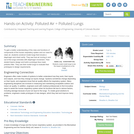
To gain a better understanding of the roles and functions of components of the human respiratory system and our need for clean air, students construct model lungs that include a diaphragm and chest cavity. They see how air moving in and out of the lungs coincides with diaphragm movement. Then student teams design and build a prototype face mask pollution filter. They use their model lungs to evaluate their prototypes to design requirements.
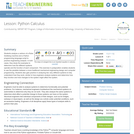
Students analyze a cartoon of a Rube Goldberg machine and a Python programming language script to practice engineering analysis. In both cases, they study the examples to determine how the different systems operate and the function of each component. This exercise in juxtaposition enables students to see the parallels between a more traditional mechanical engineering design and computer programming. Students also gain practice in analyzing two very different systems to fully understand how they work, similar to how engineers analyze systems and determine how they function and how changes to the system might affect the system.

This course provides an introduction to important philosophical questions about the mind, specifically those that are intimately connected with contemporary psychology and neuroscience. Are our concepts innate, or are they acquired by experience? (And what does it even mean to call a concept ‘innate’?) Are ‘mental images’ pictures in the head? Is color in the mind or in the world? Is the mind nothing more than the brain? Can there be a science of consciousness? The course will include guest lectures by Professors.

The purpose of this resource is to investigate the idea that every dynamic system has energy and matter in different forms.

Short video on the anatomy of the skull for anatomy and physiology.

Short video on spine and ribcage anatomy for anatomy and physiology.

Short video on the somatosensory system for anatomy and physiology.

The goal of this lecture plan "Spatial data analyzing" is to adapt the final project of Edit-027, at this time, this document helps students acquire technical skills in using GIS opensource software (QGIS) for producing, managing databases, and to develop research skills in spatial analysis.This module is for 0.5 credit hoursThis OER document was adapted from OER "Introduction to GIS for urban studies"

Short video on spinal cord anatomy for anatomy and physiology.
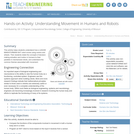
This activity helps students understand how a LEGO MINDSTORMS(TM) NXT robot moves using motors and wheels. Then students relate the concepts of decision-making actuation and motion in humans to their parallels in mechanized robots, and understand the common themes associated with movement.

Short video on urinary system anatomy for anatomy and physiology.
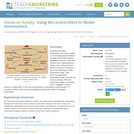
Students learn about homeostasis and create models by constructing simple feedback systems using Arduino boards, temperature sensors, LEDs and Arduino code. Starting with pre-written code, students instruct LEDs to activate in response to the sensor detecting a certain temperature range. They determine appropriate temperature ranges and alter the code accordingly. When the temperature range is exceeded, a fan is engaged in order to achieve a cooling effect. In this way, the principle of homeostasis is demonstrated. To conclude, students write summary paragraphs relating their models to biological homeostasis.
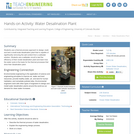
Students use a thermal process approach to design, build and test a small-scale desalination plant that is capable of significantly removing the salt content from a saltwater solution. Students use a saltwater circuit to test the efficiency of their model desalination plant and learn how the water cycle is the basis for the thermal processes that drive their desalination plant.